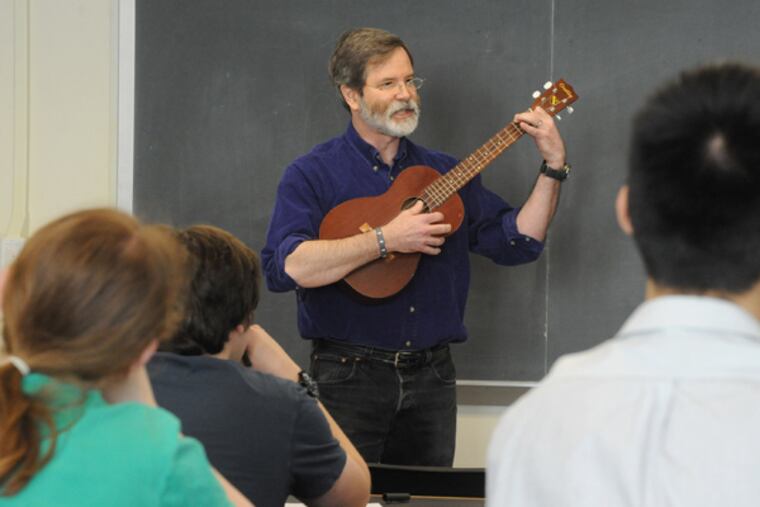Haverford professor sings basics of physics
If you have a hard time understanding Einstein's theory of relativity, maybe that's because you've never heard Walter Smith strum it on his baritone ukulele. "It's glorious and eerie, this theory; Its light is shining on me," Smith, a physics professor at Haverford College, sang to his introductory class last week in the plaintive tones of a folk troubadour. "I see time dilation and feel the elation, of relativity."

If you have a hard time understanding Einstein's theory of relativity, maybe that's because you've never heard Walter Smith strum it on his baritone ukulele.
"It's glorious and eerie, this theory; Its light is shining on me," Smith, a physics professor at Haverford College, sang to his introductory class last week in the plaintive tones of a folk troubadour. "I see time dilation and feel the elation, of relativity."
As the last note fades, his 20 students burst into applause - just as they do over the course of the semester for his swooning ballad, "The Love Song of the Electric Field," or the Broadway-style toe-tapper "Energy Eigenstates," among others.
For Smith, the creation of sound waves is more than a dry academic theory. In what may not be his most important contribution to the study of physics, the 53-year-old professor has formulated a kind of Schoolhouse Rock for the particle-theory set.
He and his librarian wife have written a large and growing songbook of original physics tunes that he performs during his lectures – teaching a new generation about scientific concepts that are even harder to rhyme than they are to understand.
"I love it," said Avi Bregman, 21, a chemistry major who hates physics but who had to take the course. "The fact that he takes the time to write songs, and some of them are original tunes, shows he cares about the class."
Smith doesn't just create sound waves from the strings of his ukulele, he's an expert on the physics behind them. The textbook he authored in 2010 - Waves and Oscillations: A Prelude to Quantum Mechanics - begins with this quote: "All around us, sinusoidal waves astound us!"
It's a line from one of his songs, of course.
Smith and his wife, Marian McKenzie, came up with the music idea in 1999 as a way to engage Smith's students and show them physics could be fun, maybe even poetic. Their first song was about Hans Christian Oersted, who discovered the connection between electricity and magnetism.
"I wasn't quite sure what to expect when I performed it, but the response of the students was fantastic," said Smith, whose research is in the field of self-assembling molecular electronics. "They absolutely loved it. Ever since, I've used songs in all of my classes, from introductory through the most advanced physics classes."
Elias Borne, 20, a chemistry major, said he really appreciated that: "Nobody wants to take physics, but at least when he sings, it makes it fun," he said.
Some graduates have even done remixes of Smith's music, students said. And Smith can claim at least one track on a CD by a former student who has a folk band.
The musical couple sing in their church choir and McKenzie also writes musicals for Friends School Haverford, where she works. Some of their songs are set to existing tunes but others are original compositions. Smith also has a website, PhysicsSongs.org, that showcases the couple's musical numbers.
All told, they've written about 65 ditties on subjects such as quantum mechanics, light, and advanced laboratory techniques. McKenzie said her husband would sometimes come to her with a tricky topic "and I'll get really inspired." That's how she came up with "The Ground Loop Blues" - a student was having trouble finding and eliminating ground loops, which are unwanted electrical currents that keep circuits from working properly.
Hard to believe, but there's a long history of singing physicists, going back to the 1920s, when professors and students at the Cavendish Laboratory at Cambridge University would write and perform physics tunes for the annual Christmas party.
At the annual March meeting of the American Physical Society, there's a sing-along with Nobel Prize winners such as William D. Phillips, who grew up in Camp Hill, Pa., belting out songs like a bunch of brainiac Nathan Lanes. It was Smith who got the shows going in 2006.
At the most recent meeting, in Baltimore, 200 people had a rollicking good time knocking back free beer and singing science songs. "It's a bit of levity that happens during this fairly serious scientific meeting," association spokesman James Riordon said.
There are YouTube videos, if you're interested.
Another reason for the classroom concerts may be that Smith sympathizes with his less-enthusiastic students. After taking a physics course in his freshman year, he remembers thinking, "Thank God I'll never have to take another physics class."
But a friend persuaded him to stick with it so they could work together. He eventually got hooked on quantum mechanics and now it is the subject of his most beloved songs.
His favorite is "Energy Eigenstates", sung to the tune of "Comedy Tonight" from A Funny Thing Happened on the Way to the Forum. "It literally brings tears to my eyes," Smith said.
"The line that really gets to me is 'Stately and calm, they've no need for haste, the lords and ladies of Hilbert space.' This refers to the idea that all quantum states can be made up by weighted averages of energy eigenstates. That's what makes them 'lords and ladies,' " he said.
And if you understand that, there's still time to sign up for next year's Physical Society sing-along.